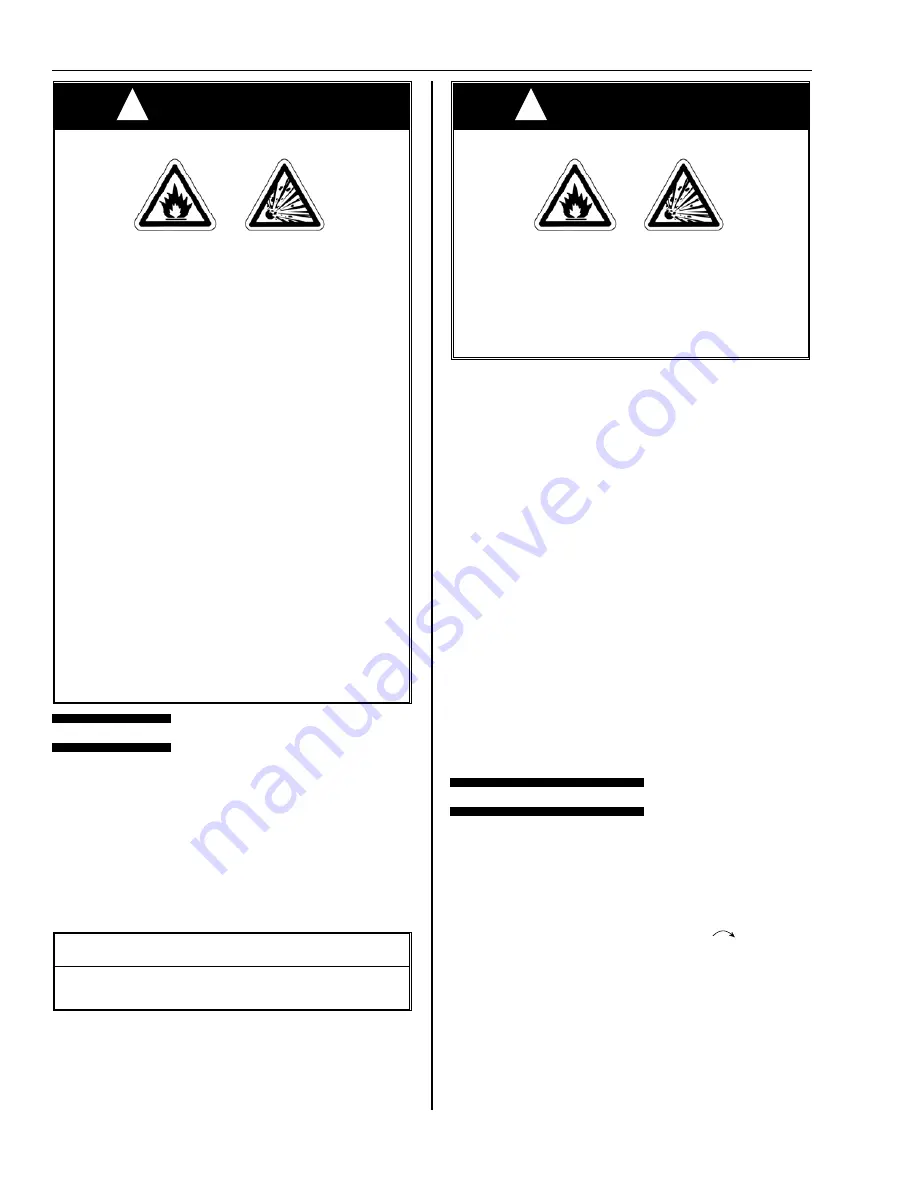
Omega II
®
Installation, Operation & Maintenance
Page 32
Combustion Research Corporation
WARNING
FIRE OR EXPLOSION HAZARD
IMPROPER INSTALLATION, ADJUSTMENT,
ALTERATION, SERVICE OR MAINTENANCE
CAN CAUSE DEATH, SEVERE INJURY
AND/OR PROPERTY DAMAGE.
1. Flame is lit automatically. Do not light the flame
manually.
2. Before lighting burner flame, smell around the
appliance for gas. Be sure to smell next to floor
because LP gas is heavier than air.
3. IF YOU SMELL GAS:
Turn off the gas supply at the appliance service
valve. On LP gas systems, turn off gas supply at
the gas tank.
Do not light any appliances in the house.
Do not touch electrical switches or use the phone.
Leave the building and use a neighbor's phone to
call your gas supplier.
If you cannot reach your gas supplier, call the fire
department
.
4. Do not force the gas control knob. Use only your
hand to push down or turn the gas control knob.
Never use any tools. If the gas control knob will not
operate by hand, a qualified service technician should
replace the gas control. Force or attempted repair
may result in a fire or explosion.
5. The gas control must be replaced in case of any
physical damage, tampering, bent terminals, missing
or broken parts, stripped threads, and evidence of
exposure to heat.
MAINTENANCE
Regular preventive maintenance is important in applications
that place a heavy load on system controls, such as in the
commercial cooking and agricultural and industrial
industries because:
1. In applications where the equipment operates 100,000-
200,000 cycles per year. Such heavy cycling can wear
out the gas control in one to two years.
2. Exposure to water, dirt, chemicals and heat can damage
the gas control and shut down the control system.
NOTICE
Do not apply a jumper across or short the valve coil
terminals. Doing so may damage the ignition module.
WARNING
FIRE OR EXPLOSION HAZARD
IMPROPER INSTALLATION, ADJUSTMENT,
ALTERATION, SERVICE OR MAINTENANCE
CAN CAUSE DEATH, SEVERE INJURY
AND/OR PROPERTY DAMAGE.
Do not disassemble the gas control. The gas control
contains no replaceable components. Attempted
disassembly or repair may damage the gas control.
The maintenance program
should include regular
checkout of the gas control. Maintenance frequency must
be determined individually for each application. Some
considerations are:
1.
Cycling frequency.
Appliances that may cycle 100,000
times annually should be checked monthly.
2.
Intermittent use.
Appliances that are used seasonally
should be checked before shutdown and again before the
next use.
3.
Consequence of unexpected shutdown.
Where the
cost of an unexpected shutdown would be high, the system
should be checked more often.
4.
Dusty, wet or corrosive environment.
Since these
environments can cause the gas control to deteriorate more
rapidly, the system should be checked more often.
The gas control should be replaced if
:
1. It does not perform properly on checkout or trouble-
shooting.
2. The gas control knob is hard to turn or push down, or it
fails to pop back up when released.
3. The gas control is likely to have operated for more than
200,000 cycles.
CHECKOUT PROCEDURE
Before leaving installation, several complete operating
cycles should be observed to see that all components are
functioning properly.
1. Before turning on the main electrical power switch, be
sure all gas supply lines are purged of air.
2. Close main manual shutoff valve and wait for 5 minutes,
then turn "A" valve to counter clockwise
to "ON"
position.
CAUTION: Check for positive gas seal using soap
solution on valve inlet and all upstream pipe
connections.
3. Turn on main electrical power switch and close
thermostat contacts.
4. After the control is powered it will automatically energize
the spark and the gas valve.
!
!
Summary of Contents for Omega II
Page 40: ...Omega II Installation Operation Maintenance Page 36 Combustion Research Corporation...
Page 48: ......
Page 49: ......















































